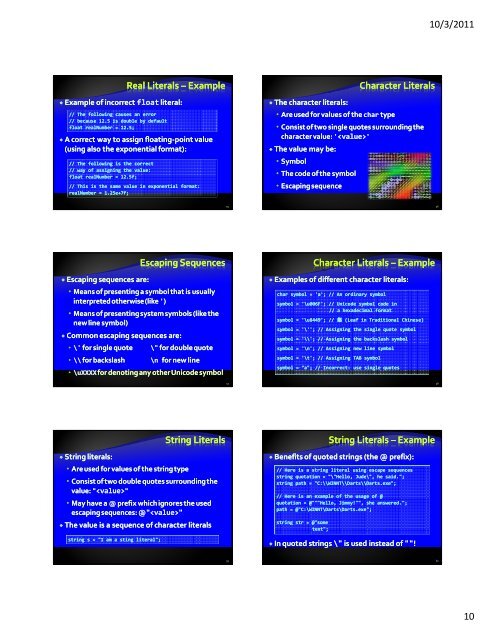Primitive Data Types and Variables - EEMB DERSLER
Primitive Data Types and Variables - EEMB DERSLER
Primitive Data Types and Variables - EEMB DERSLER
Create successful ePaper yourself
Turn your PDF publications into a flip-book with our unique Google optimized e-Paper software.
Real Literals – Example<br />
Example of incorrect float literal:<br />
// The following causes an error<br />
// because 12.5 is double by default<br />
float realNumber = 12.5;<br />
A correct way to assign floating floating-point point value<br />
(using also the exponential format):<br />
// The following is the correct<br />
// way of assigning the value:<br />
float realNumber = 12.5f;<br />
// This is the same value in exponential format:<br />
realNumber = 1.25e+7f;<br />
Escaping sequences are:<br />
Escaping Sequences<br />
Means of presenting a symbol that is usually<br />
interpreted otherwise (like ')<br />
Means of presenting system symbols (like the<br />
new line symbol)<br />
Common escaping sequences are:<br />
\' for single quote \" for double quote<br />
\\ for backslash \n for new line<br />
\uXXXX uXXXXfor for denoting any other Unicode symbol<br />
String literals:<br />
Are used for values of the string type<br />
String Literals<br />
Consist of two double quotes surrounding the<br />
value: " "<br />
May have a @ prefix which ignores the used<br />
escaping sequences: @"" ""<br />
The value is a sequence of character literals<br />
string s = "I am a sting literal";<br />
55<br />
57<br />
59<br />
The character literals:<br />
Are used for values of the char type<br />
Character Literals<br />
Consist of two single quotes surrounding the<br />
character value value: : ' '<br />
The value may be:<br />
Symbol<br />
The code of the symbol<br />
Escaping sequence<br />
Character Literals – Example<br />
Examples of different character literals:<br />
char symbol = 'a'; // An ordinary symbol<br />
symbol = ''\u006F';<br />
u006F'; // Unicode symbol code in<br />
// a hexadecimal format<br />
symbol = ''\u8449';<br />
u8449'; // 葉 (Leaf Leaf in Traditional Chinese)<br />
symbol = ''\'';<br />
''; // Assigning the single quote symbol<br />
symbol = ''\\';<br />
'; // Assigning the backslash symbol<br />
symbol = ''\n';<br />
n'; // Assigning new line symbol<br />
symbol = ''\t';<br />
t'; // Assigning TAB symbol<br />
symbol = "a"; // Incorrect: use single quotes<br />
String Literals – Example<br />
Benefits of quoted strings (the @ prefix):<br />
// Here is a string literal using escape sequences<br />
string quotation = " "\"Hello, "Hello, Jude\", Jude ", he said.";<br />
string path = "C: "C:\\WINNT WINNT\\Darts Darts\\Darts.exe";<br />
Darts.exe";<br />
// Here is an example of the usage of @<br />
quotation = @"""Hello, Jimmy!"", she answered.";<br />
path = @"C: @"C:\WINNT WINNT\Darts Darts\Darts.exe Darts.exe"; ";<br />
string str = @"some<br />
text";<br />
In quoted strings \" is used instead of "" ""!<br />
10/3/2011<br />
56<br />
58<br />
60<br />
10



